Financial Reporting and IFRS Adoption
VerifiedAdded on 2020/06/04
|10
|3155
|58
AI Summary
This assignment analyzes the significance of financial reporting for businesses, exploring how it aids decision-making. It delves into the advantages of International Financial Reporting Standards (IFRS) in enhancing reporting quality and facilitating informed decisions. The paper also investigates factors hindering IFRS adoption, such as the need for comprehensive accounting system overhauls.
Contribute Materials
Your contribution can guide someone’s learning journey. Share your
documents today.

FINANCIAL REPORTING
Secure Best Marks with AI Grader
Need help grading? Try our AI Grader for instant feedback on your assignments.
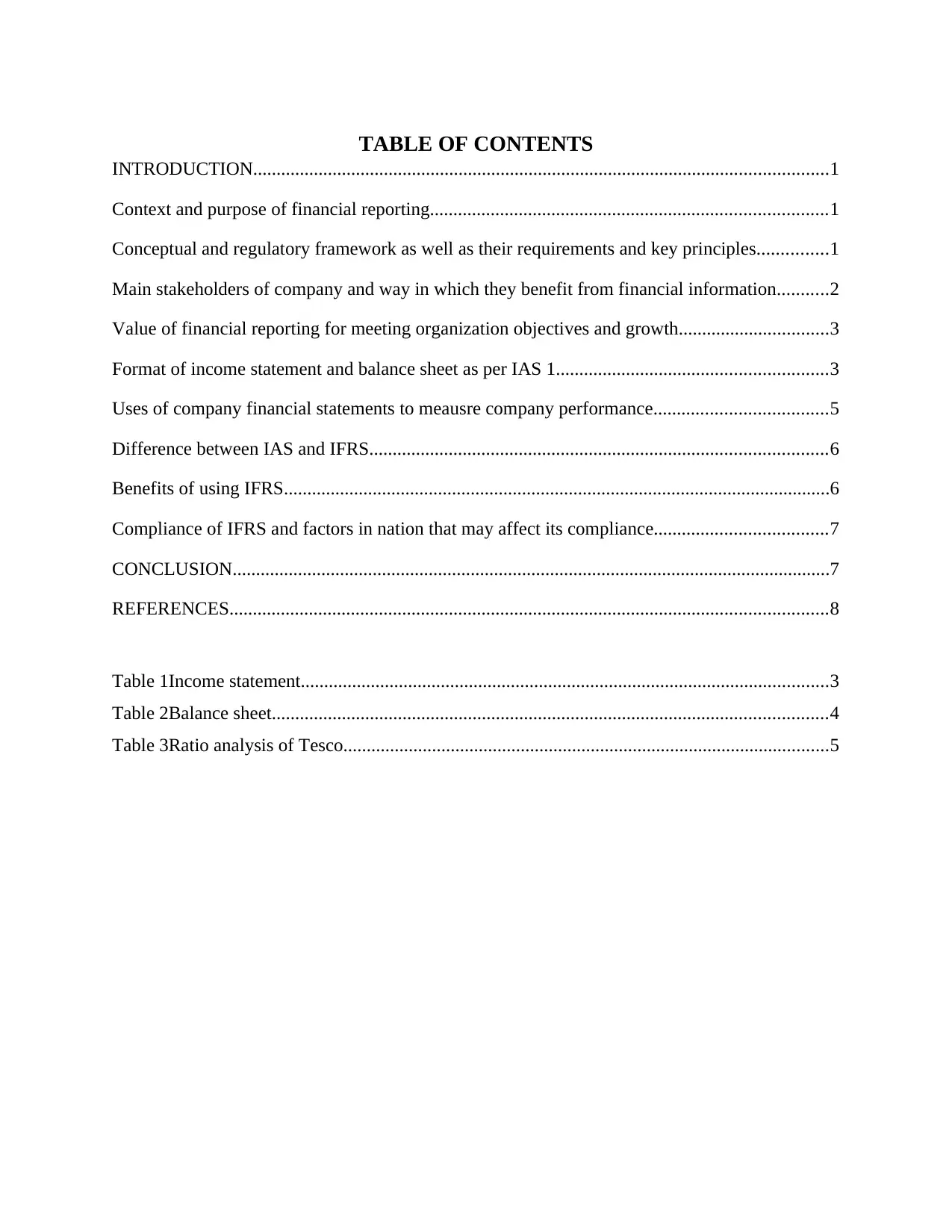
TABLE OF CONTENTS
INTRODUCTION...........................................................................................................................1
Context and purpose of financial reporting.....................................................................................1
Conceptual and regulatory framework as well as their requirements and key principles...............1
Main stakeholders of company and way in which they benefit from financial information...........2
Value of financial reporting for meeting organization objectives and growth................................3
Format of income statement and balance sheet as per IAS 1..........................................................3
Uses of company financial statements to meausre company performance.....................................5
Difference between IAS and IFRS..................................................................................................6
Benefits of using IFRS.....................................................................................................................6
Compliance of IFRS and factors in nation that may affect its compliance.....................................7
CONCLUSION................................................................................................................................7
REFERENCES................................................................................................................................8
Table 1Income statement.................................................................................................................3
Table 2Balance sheet.......................................................................................................................4
Table 3Ratio analysis of Tesco........................................................................................................5
INTRODUCTION...........................................................................................................................1
Context and purpose of financial reporting.....................................................................................1
Conceptual and regulatory framework as well as their requirements and key principles...............1
Main stakeholders of company and way in which they benefit from financial information...........2
Value of financial reporting for meeting organization objectives and growth................................3
Format of income statement and balance sheet as per IAS 1..........................................................3
Uses of company financial statements to meausre company performance.....................................5
Difference between IAS and IFRS..................................................................................................6
Benefits of using IFRS.....................................................................................................................6
Compliance of IFRS and factors in nation that may affect its compliance.....................................7
CONCLUSION................................................................................................................................7
REFERENCES................................................................................................................................8
Table 1Income statement.................................................................................................................3
Table 2Balance sheet.......................................................................................................................4
Table 3Ratio analysis of Tesco........................................................................................................5
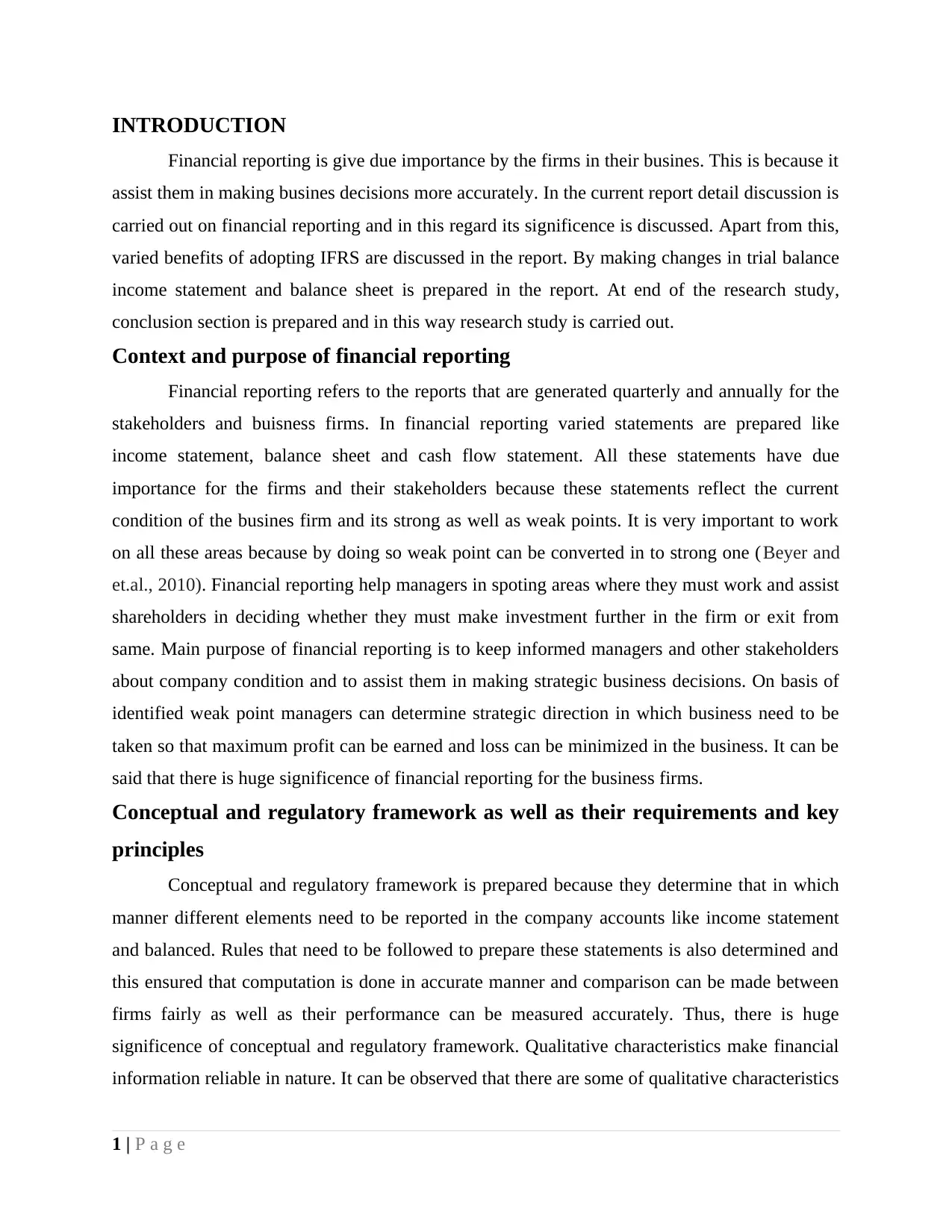
INTRODUCTION
Financial reporting is give due importance by the firms in their busines. This is because it
assist them in making busines decisions more accurately. In the current report detail discussion is
carried out on financial reporting and in this regard its significence is discussed. Apart from this,
varied benefits of adopting IFRS are discussed in the report. By making changes in trial balance
income statement and balance sheet is prepared in the report. At end of the research study,
conclusion section is prepared and in this way research study is carried out.
Context and purpose of financial reporting
Financial reporting refers to the reports that are generated quarterly and annually for the
stakeholders and buisness firms. In financial reporting varied statements are prepared like
income statement, balance sheet and cash flow statement. All these statements have due
importance for the firms and their stakeholders because these statements reflect the current
condition of the busines firm and its strong as well as weak points. It is very important to work
on all these areas because by doing so weak point can be converted in to strong one (Beyer and
et.al., 2010). Financial reporting help managers in spoting areas where they must work and assist
shareholders in deciding whether they must make investment further in the firm or exit from
same. Main purpose of financial reporting is to keep informed managers and other stakeholders
about company condition and to assist them in making strategic business decisions. On basis of
identified weak point managers can determine strategic direction in which business need to be
taken so that maximum profit can be earned and loss can be minimized in the business. It can be
said that there is huge significence of financial reporting for the business firms.
Conceptual and regulatory framework as well as their requirements and key
principles
Conceptual and regulatory framework is prepared because they determine that in which
manner different elements need to be reported in the company accounts like income statement
and balanced. Rules that need to be followed to prepare these statements is also determined and
this ensured that computation is done in accurate manner and comparison can be made between
firms fairly as well as their performance can be measured accurately. Thus, there is huge
significence of conceptual and regulatory framework. Qualitative characteristics make financial
information reliable in nature. It can be observed that there are some of qualitative characteristics
1 | P a g e
Financial reporting is give due importance by the firms in their busines. This is because it
assist them in making busines decisions more accurately. In the current report detail discussion is
carried out on financial reporting and in this regard its significence is discussed. Apart from this,
varied benefits of adopting IFRS are discussed in the report. By making changes in trial balance
income statement and balance sheet is prepared in the report. At end of the research study,
conclusion section is prepared and in this way research study is carried out.
Context and purpose of financial reporting
Financial reporting refers to the reports that are generated quarterly and annually for the
stakeholders and buisness firms. In financial reporting varied statements are prepared like
income statement, balance sheet and cash flow statement. All these statements have due
importance for the firms and their stakeholders because these statements reflect the current
condition of the busines firm and its strong as well as weak points. It is very important to work
on all these areas because by doing so weak point can be converted in to strong one (Beyer and
et.al., 2010). Financial reporting help managers in spoting areas where they must work and assist
shareholders in deciding whether they must make investment further in the firm or exit from
same. Main purpose of financial reporting is to keep informed managers and other stakeholders
about company condition and to assist them in making strategic business decisions. On basis of
identified weak point managers can determine strategic direction in which business need to be
taken so that maximum profit can be earned and loss can be minimized in the business. It can be
said that there is huge significence of financial reporting for the business firms.
Conceptual and regulatory framework as well as their requirements and key
principles
Conceptual and regulatory framework is prepared because they determine that in which
manner different elements need to be reported in the company accounts like income statement
and balanced. Rules that need to be followed to prepare these statements is also determined and
this ensured that computation is done in accurate manner and comparison can be made between
firms fairly as well as their performance can be measured accurately. Thus, there is huge
significence of conceptual and regulatory framework. Qualitative characteristics make financial
information reliable in nature. It can be observed that there are some of qualitative characteristics
1 | P a g e
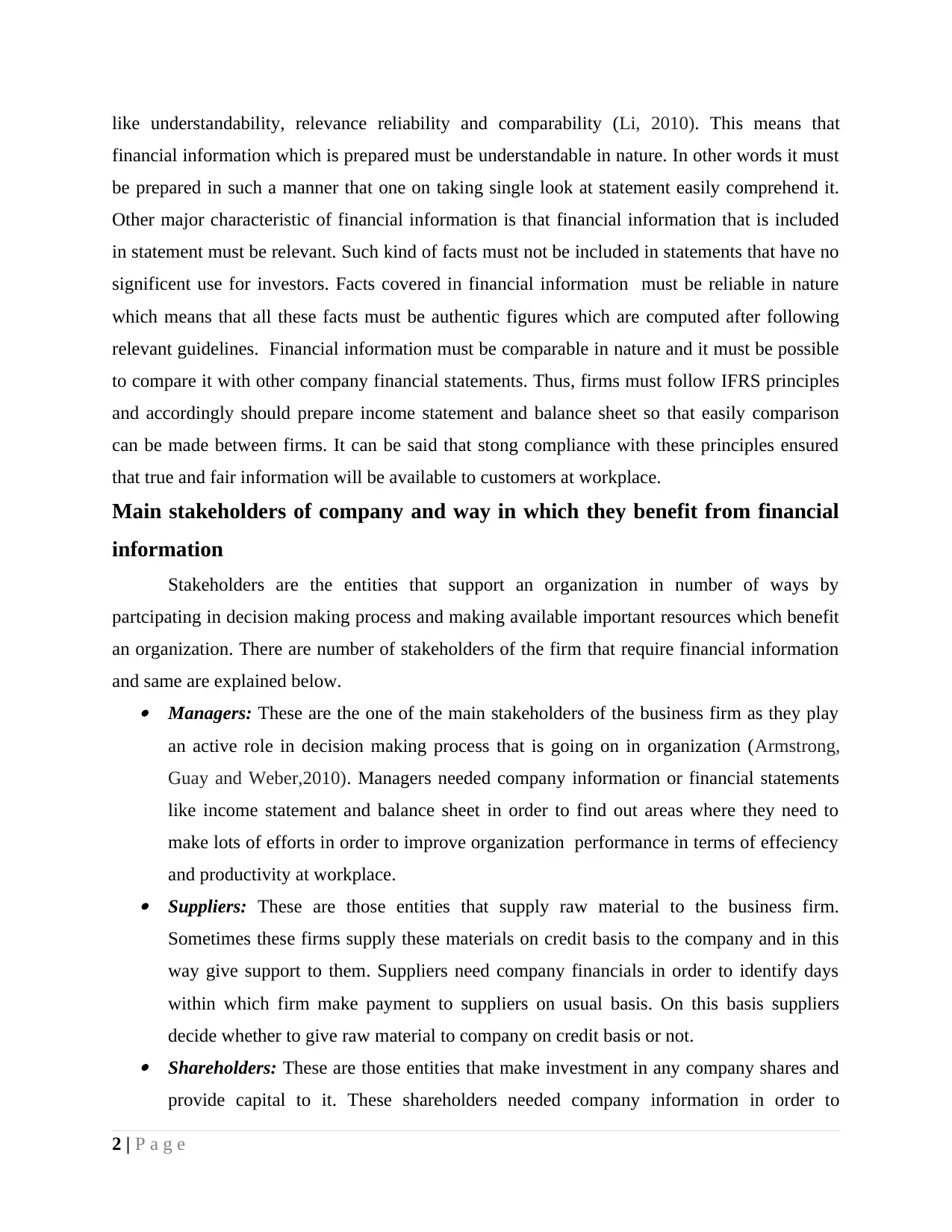
like understandability, relevance reliability and comparability (Li, 2010). This means that
financial information which is prepared must be understandable in nature. In other words it must
be prepared in such a manner that one on taking single look at statement easily comprehend it.
Other major characteristic of financial information is that financial information that is included
in statement must be relevant. Such kind of facts must not be included in statements that have no
significent use for investors. Facts covered in financial information must be reliable in nature
which means that all these facts must be authentic figures which are computed after following
relevant guidelines. Financial information must be comparable in nature and it must be possible
to compare it with other company financial statements. Thus, firms must follow IFRS principles
and accordingly should prepare income statement and balance sheet so that easily comparison
can be made between firms. It can be said that stong compliance with these principles ensured
that true and fair information will be available to customers at workplace.
Main stakeholders of company and way in which they benefit from financial
information
Stakeholders are the entities that support an organization in number of ways by
partcipating in decision making process and making available important resources which benefit
an organization. There are number of stakeholders of the firm that require financial information
and same are explained below. Managers: These are the one of the main stakeholders of the business firm as they play
an active role in decision making process that is going on in organization (Armstrong,
Guay and Weber,2010). Managers needed company information or financial statements
like income statement and balance sheet in order to find out areas where they need to
make lots of efforts in order to improve organization performance in terms of effeciency
and productivity at workplace. Suppliers: These are those entities that supply raw material to the business firm.
Sometimes these firms supply these materials on credit basis to the company and in this
way give support to them. Suppliers need company financials in order to identify days
within which firm make payment to suppliers on usual basis. On this basis suppliers
decide whether to give raw material to company on credit basis or not. Shareholders: These are those entities that make investment in any company shares and
provide capital to it. These shareholders needed company information in order to
2 | P a g e
financial information which is prepared must be understandable in nature. In other words it must
be prepared in such a manner that one on taking single look at statement easily comprehend it.
Other major characteristic of financial information is that financial information that is included
in statement must be relevant. Such kind of facts must not be included in statements that have no
significent use for investors. Facts covered in financial information must be reliable in nature
which means that all these facts must be authentic figures which are computed after following
relevant guidelines. Financial information must be comparable in nature and it must be possible
to compare it with other company financial statements. Thus, firms must follow IFRS principles
and accordingly should prepare income statement and balance sheet so that easily comparison
can be made between firms. It can be said that stong compliance with these principles ensured
that true and fair information will be available to customers at workplace.
Main stakeholders of company and way in which they benefit from financial
information
Stakeholders are the entities that support an organization in number of ways by
partcipating in decision making process and making available important resources which benefit
an organization. There are number of stakeholders of the firm that require financial information
and same are explained below. Managers: These are the one of the main stakeholders of the business firm as they play
an active role in decision making process that is going on in organization (Armstrong,
Guay and Weber,2010). Managers needed company information or financial statements
like income statement and balance sheet in order to find out areas where they need to
make lots of efforts in order to improve organization performance in terms of effeciency
and productivity at workplace. Suppliers: These are those entities that supply raw material to the business firm.
Sometimes these firms supply these materials on credit basis to the company and in this
way give support to them. Suppliers need company financials in order to identify days
within which firm make payment to suppliers on usual basis. On this basis suppliers
decide whether to give raw material to company on credit basis or not. Shareholders: These are those entities that make investment in any company shares and
provide capital to it. These shareholders needed company information in order to
2 | P a g e
Secure Best Marks with AI Grader
Need help grading? Try our AI Grader for instant feedback on your assignments.
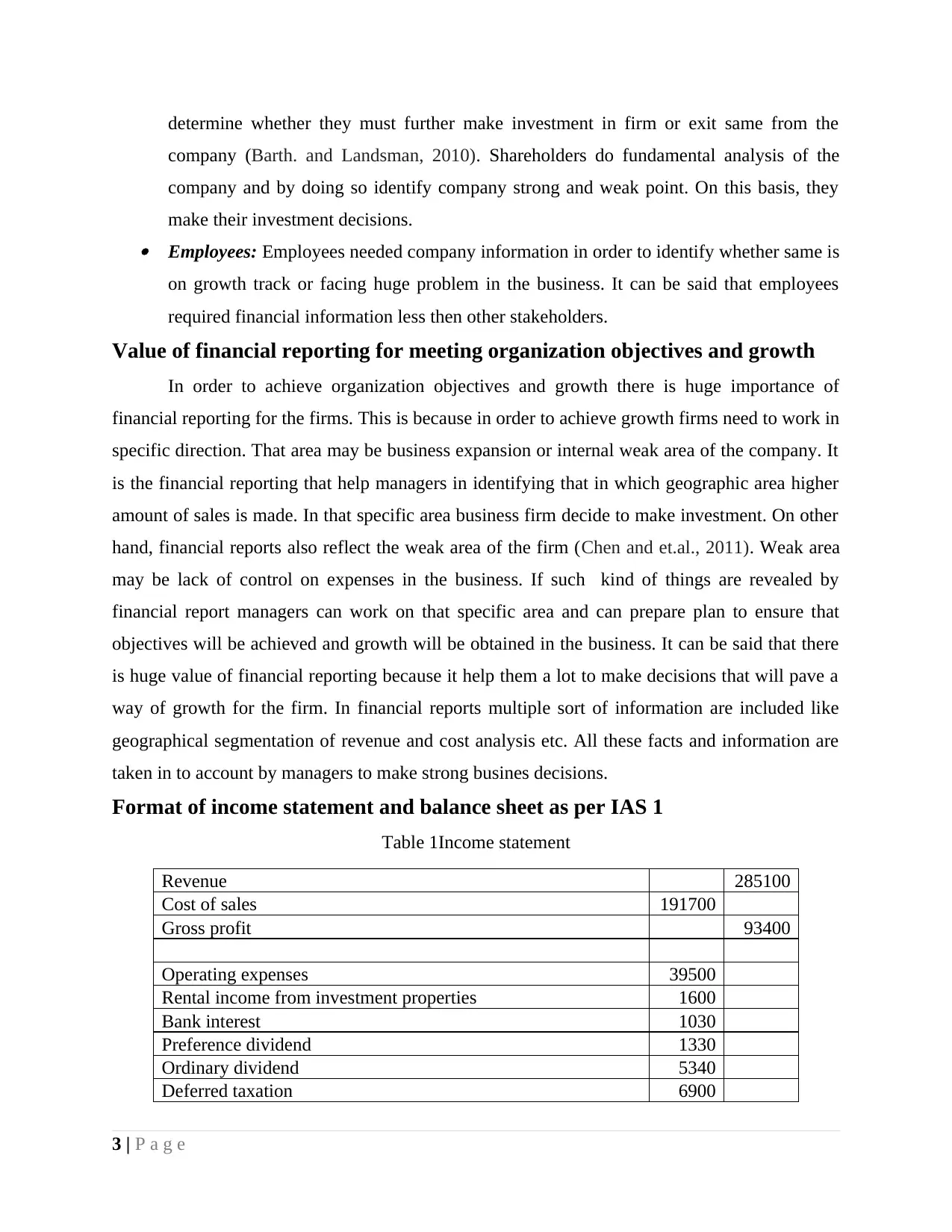
determine whether they must further make investment in firm or exit same from the
company (Barth. and Landsman, 2010). Shareholders do fundamental analysis of the
company and by doing so identify company strong and weak point. On this basis, they
make their investment decisions. Employees: Employees needed company information in order to identify whether same is
on growth track or facing huge problem in the business. It can be said that employees
required financial information less then other stakeholders.
Value of financial reporting for meeting organization objectives and growth
In order to achieve organization objectives and growth there is huge importance of
financial reporting for the firms. This is because in order to achieve growth firms need to work in
specific direction. That area may be business expansion or internal weak area of the company. It
is the financial reporting that help managers in identifying that in which geographic area higher
amount of sales is made. In that specific area business firm decide to make investment. On other
hand, financial reports also reflect the weak area of the firm (Chen and et.al., 2011). Weak area
may be lack of control on expenses in the business. If such kind of things are revealed by
financial report managers can work on that specific area and can prepare plan to ensure that
objectives will be achieved and growth will be obtained in the business. It can be said that there
is huge value of financial reporting because it help them a lot to make decisions that will pave a
way of growth for the firm. In financial reports multiple sort of information are included like
geographical segmentation of revenue and cost analysis etc. All these facts and information are
taken in to account by managers to make strong busines decisions.
Format of income statement and balance sheet as per IAS 1
Table 1Income statement
Revenue 285100
Cost of sales 191700
Gross profit 93400
Operating expenses 39500
Rental income from investment properties 1600
Bank interest 1030
Preference dividend 1330
Ordinary dividend 5340
Deferred taxation 6900
3 | P a g e
company (Barth. and Landsman, 2010). Shareholders do fundamental analysis of the
company and by doing so identify company strong and weak point. On this basis, they
make their investment decisions. Employees: Employees needed company information in order to identify whether same is
on growth track or facing huge problem in the business. It can be said that employees
required financial information less then other stakeholders.
Value of financial reporting for meeting organization objectives and growth
In order to achieve organization objectives and growth there is huge importance of
financial reporting for the firms. This is because in order to achieve growth firms need to work in
specific direction. That area may be business expansion or internal weak area of the company. It
is the financial reporting that help managers in identifying that in which geographic area higher
amount of sales is made. In that specific area business firm decide to make investment. On other
hand, financial reports also reflect the weak area of the firm (Chen and et.al., 2011). Weak area
may be lack of control on expenses in the business. If such kind of things are revealed by
financial report managers can work on that specific area and can prepare plan to ensure that
objectives will be achieved and growth will be obtained in the business. It can be said that there
is huge value of financial reporting because it help them a lot to make decisions that will pave a
way of growth for the firm. In financial reports multiple sort of information are included like
geographical segmentation of revenue and cost analysis etc. All these facts and information are
taken in to account by managers to make strong busines decisions.
Format of income statement and balance sheet as per IAS 1
Table 1Income statement
Revenue 285100
Cost of sales 191700
Gross profit 93400
Operating expenses 39500
Rental income from investment properties 1600
Bank interest 1030
Preference dividend 1330
Ordinary dividend 5340
Deferred taxation 6900
3 | P a g e
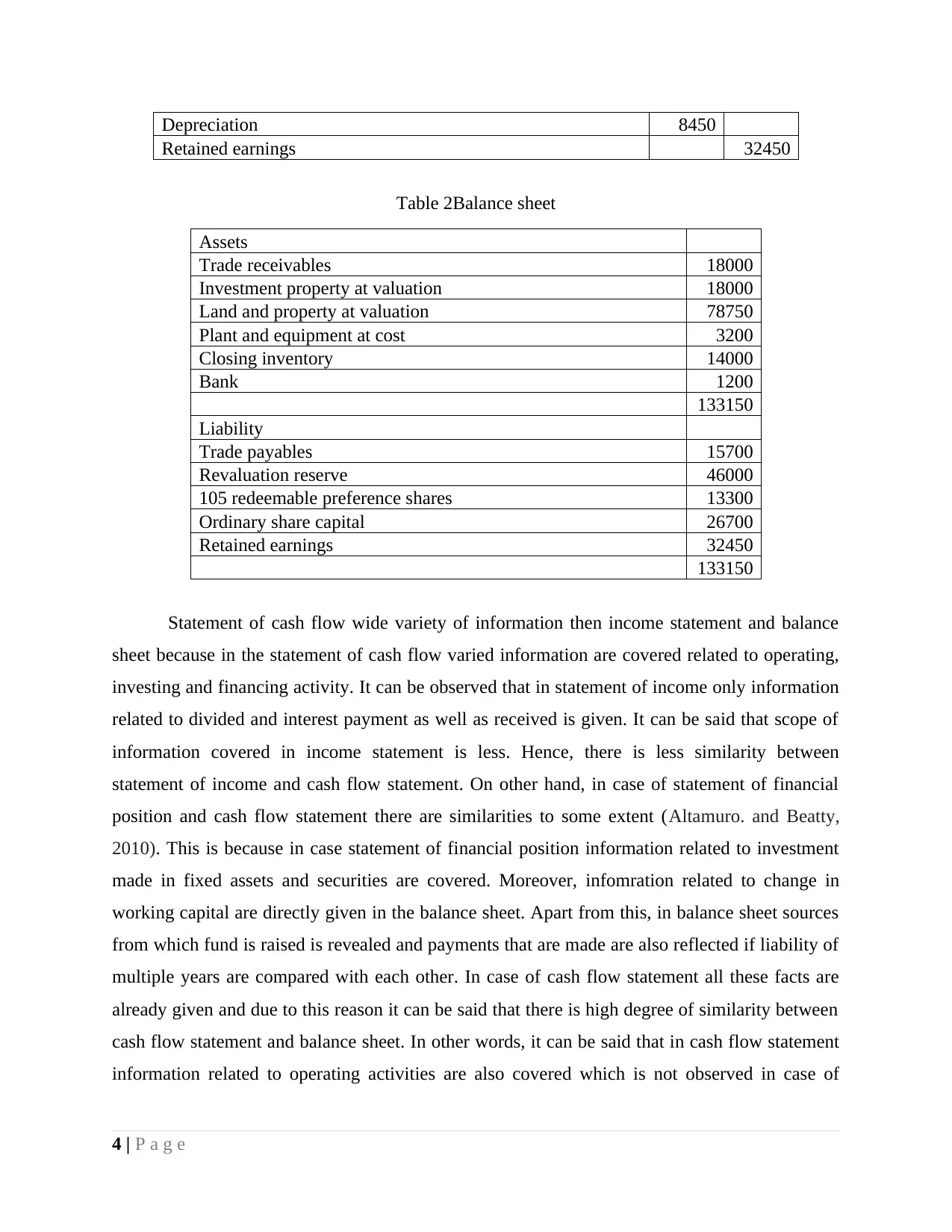
Depreciation 8450
Retained earnings 32450
Table 2Balance sheet
Assets
Trade receivables 18000
Investment property at valuation 18000
Land and property at valuation 78750
Plant and equipment at cost 3200
Closing inventory 14000
Bank 1200
133150
Liability
Trade payables 15700
Revaluation reserve 46000
105 redeemable preference shares 13300
Ordinary share capital 26700
Retained earnings 32450
133150
Statement of cash flow wide variety of information then income statement and balance
sheet because in the statement of cash flow varied information are covered related to operating,
investing and financing activity. It can be observed that in statement of income only information
related to divided and interest payment as well as received is given. It can be said that scope of
information covered in income statement is less. Hence, there is less similarity between
statement of income and cash flow statement. On other hand, in case of statement of financial
position and cash flow statement there are similarities to some extent (Altamuro. and Beatty,
2010). This is because in case statement of financial position information related to investment
made in fixed assets and securities are covered. Moreover, infomration related to change in
working capital are directly given in the balance sheet. Apart from this, in balance sheet sources
from which fund is raised is revealed and payments that are made are also reflected if liability of
multiple years are compared with each other. In case of cash flow statement all these facts are
already given and due to this reason it can be said that there is high degree of similarity between
cash flow statement and balance sheet. In other words, it can be said that in cash flow statement
information related to operating activities are also covered which is not observed in case of
4 | P a g e
Retained earnings 32450
Table 2Balance sheet
Assets
Trade receivables 18000
Investment property at valuation 18000
Land and property at valuation 78750
Plant and equipment at cost 3200
Closing inventory 14000
Bank 1200
133150
Liability
Trade payables 15700
Revaluation reserve 46000
105 redeemable preference shares 13300
Ordinary share capital 26700
Retained earnings 32450
133150
Statement of cash flow wide variety of information then income statement and balance
sheet because in the statement of cash flow varied information are covered related to operating,
investing and financing activity. It can be observed that in statement of income only information
related to divided and interest payment as well as received is given. It can be said that scope of
information covered in income statement is less. Hence, there is less similarity between
statement of income and cash flow statement. On other hand, in case of statement of financial
position and cash flow statement there are similarities to some extent (Altamuro. and Beatty,
2010). This is because in case statement of financial position information related to investment
made in fixed assets and securities are covered. Moreover, infomration related to change in
working capital are directly given in the balance sheet. Apart from this, in balance sheet sources
from which fund is raised is revealed and payments that are made are also reflected if liability of
multiple years are compared with each other. In case of cash flow statement all these facts are
already given and due to this reason it can be said that there is high degree of similarity between
cash flow statement and balance sheet. In other words, it can be said that in cash flow statement
information related to operating activities are also covered which is not observed in case of
4 | P a g e
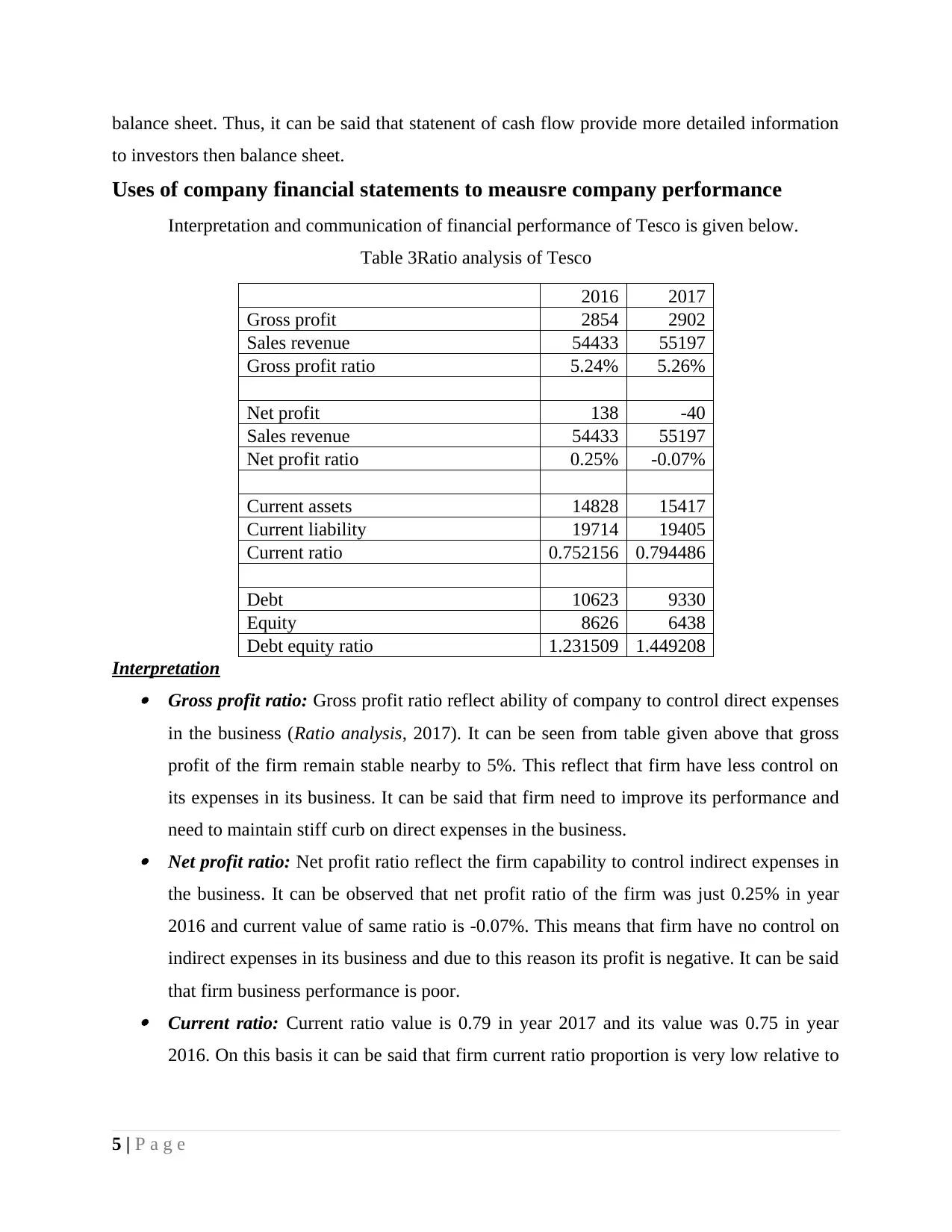
balance sheet. Thus, it can be said that statenent of cash flow provide more detailed information
to investors then balance sheet.
Uses of company financial statements to meausre company performance
Interpretation and communication of financial performance of Tesco is given below.
Table 3Ratio analysis of Tesco
2016 2017
Gross profit 2854 2902
Sales revenue 54433 55197
Gross profit ratio 5.24% 5.26%
Net profit 138 -40
Sales revenue 54433 55197
Net profit ratio 0.25% -0.07%
Current assets 14828 15417
Current liability 19714 19405
Current ratio 0.752156 0.794486
Debt 10623 9330
Equity 8626 6438
Debt equity ratio 1.231509 1.449208
Interpretation Gross profit ratio: Gross profit ratio reflect ability of company to control direct expenses
in the business (Ratio analysis, 2017). It can be seen from table given above that gross
profit of the firm remain stable nearby to 5%. This reflect that firm have less control on
its expenses in its business. It can be said that firm need to improve its performance and
need to maintain stiff curb on direct expenses in the business. Net profit ratio: Net profit ratio reflect the firm capability to control indirect expenses in
the business. It can be observed that net profit ratio of the firm was just 0.25% in year
2016 and current value of same ratio is -0.07%. This means that firm have no control on
indirect expenses in its business and due to this reason its profit is negative. It can be said
that firm business performance is poor. Current ratio: Current ratio value is 0.79 in year 2017 and its value was 0.75 in year
2016. On this basis it can be said that firm current ratio proportion is very low relative to
5 | P a g e
to investors then balance sheet.
Uses of company financial statements to meausre company performance
Interpretation and communication of financial performance of Tesco is given below.
Table 3Ratio analysis of Tesco
2016 2017
Gross profit 2854 2902
Sales revenue 54433 55197
Gross profit ratio 5.24% 5.26%
Net profit 138 -40
Sales revenue 54433 55197
Net profit ratio 0.25% -0.07%
Current assets 14828 15417
Current liability 19714 19405
Current ratio 0.752156 0.794486
Debt 10623 9330
Equity 8626 6438
Debt equity ratio 1.231509 1.449208
Interpretation Gross profit ratio: Gross profit ratio reflect ability of company to control direct expenses
in the business (Ratio analysis, 2017). It can be seen from table given above that gross
profit of the firm remain stable nearby to 5%. This reflect that firm have less control on
its expenses in its business. It can be said that firm need to improve its performance and
need to maintain stiff curb on direct expenses in the business. Net profit ratio: Net profit ratio reflect the firm capability to control indirect expenses in
the business. It can be observed that net profit ratio of the firm was just 0.25% in year
2016 and current value of same ratio is -0.07%. This means that firm have no control on
indirect expenses in its business and due to this reason its profit is negative. It can be said
that firm business performance is poor. Current ratio: Current ratio value is 0.79 in year 2017 and its value was 0.75 in year
2016. On this basis it can be said that firm current ratio proportion is very low relative to
5 | P a g e
Paraphrase This Document
Need a fresh take? Get an instant paraphrase of this document with our AI Paraphraser
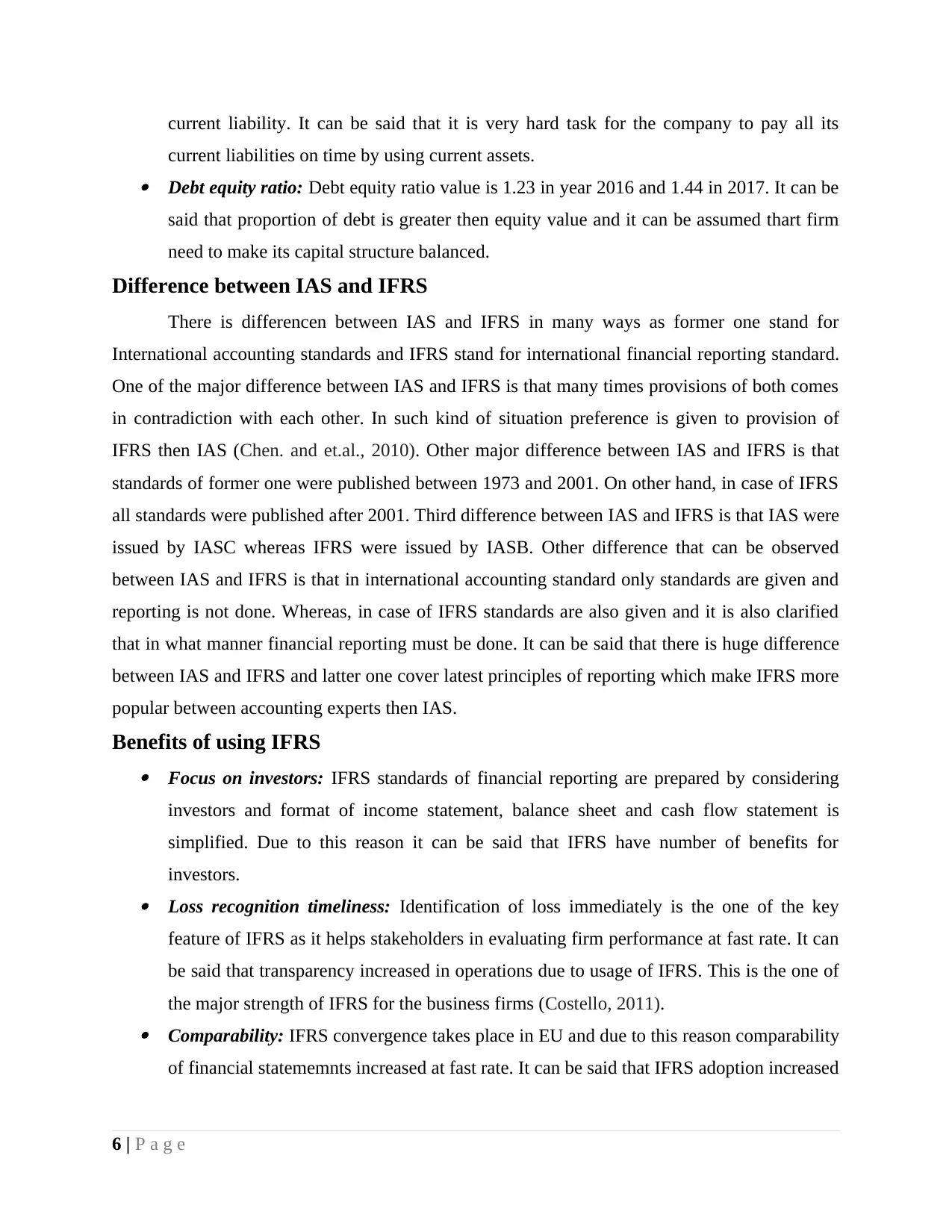
current liability. It can be said that it is very hard task for the company to pay all its
current liabilities on time by using current assets. Debt equity ratio: Debt equity ratio value is 1.23 in year 2016 and 1.44 in 2017. It can be
said that proportion of debt is greater then equity value and it can be assumed thart firm
need to make its capital structure balanced.
Difference between IAS and IFRS
There is differencen between IAS and IFRS in many ways as former one stand for
International accounting standards and IFRS stand for international financial reporting standard.
One of the major difference between IAS and IFRS is that many times provisions of both comes
in contradiction with each other. In such kind of situation preference is given to provision of
IFRS then IAS (Chen. and et.al., 2010). Other major difference between IAS and IFRS is that
standards of former one were published between 1973 and 2001. On other hand, in case of IFRS
all standards were published after 2001. Third difference between IAS and IFRS is that IAS were
issued by IASC whereas IFRS were issued by IASB. Other difference that can be observed
between IAS and IFRS is that in international accounting standard only standards are given and
reporting is not done. Whereas, in case of IFRS standards are also given and it is also clarified
that in what manner financial reporting must be done. It can be said that there is huge difference
between IAS and IFRS and latter one cover latest principles of reporting which make IFRS more
popular between accounting experts then IAS.
Benefits of using IFRS Focus on investors: IFRS standards of financial reporting are prepared by considering
investors and format of income statement, balance sheet and cash flow statement is
simplified. Due to this reason it can be said that IFRS have number of benefits for
investors. Loss recognition timeliness: Identification of loss immediately is the one of the key
feature of IFRS as it helps stakeholders in evaluating firm performance at fast rate. It can
be said that transparency increased in operations due to usage of IFRS. This is the one of
the major strength of IFRS for the business firms (Costello, 2011). Comparability: IFRS convergence takes place in EU and due to this reason comparability
of financial statememnts increased at fast rate. It can be said that IFRS adoption increased
6 | P a g e
current liabilities on time by using current assets. Debt equity ratio: Debt equity ratio value is 1.23 in year 2016 and 1.44 in 2017. It can be
said that proportion of debt is greater then equity value and it can be assumed thart firm
need to make its capital structure balanced.
Difference between IAS and IFRS
There is differencen between IAS and IFRS in many ways as former one stand for
International accounting standards and IFRS stand for international financial reporting standard.
One of the major difference between IAS and IFRS is that many times provisions of both comes
in contradiction with each other. In such kind of situation preference is given to provision of
IFRS then IAS (Chen. and et.al., 2010). Other major difference between IAS and IFRS is that
standards of former one were published between 1973 and 2001. On other hand, in case of IFRS
all standards were published after 2001. Third difference between IAS and IFRS is that IAS were
issued by IASC whereas IFRS were issued by IASB. Other difference that can be observed
between IAS and IFRS is that in international accounting standard only standards are given and
reporting is not done. Whereas, in case of IFRS standards are also given and it is also clarified
that in what manner financial reporting must be done. It can be said that there is huge difference
between IAS and IFRS and latter one cover latest principles of reporting which make IFRS more
popular between accounting experts then IAS.
Benefits of using IFRS Focus on investors: IFRS standards of financial reporting are prepared by considering
investors and format of income statement, balance sheet and cash flow statement is
simplified. Due to this reason it can be said that IFRS have number of benefits for
investors. Loss recognition timeliness: Identification of loss immediately is the one of the key
feature of IFRS as it helps stakeholders in evaluating firm performance at fast rate. It can
be said that transparency increased in operations due to usage of IFRS. This is the one of
the major strength of IFRS for the business firms (Costello, 2011). Comparability: IFRS convergence takes place in EU and due to this reason comparability
of financial statememnts increased at fast rate. It can be said that IFRS adoption increased
6 | P a g e
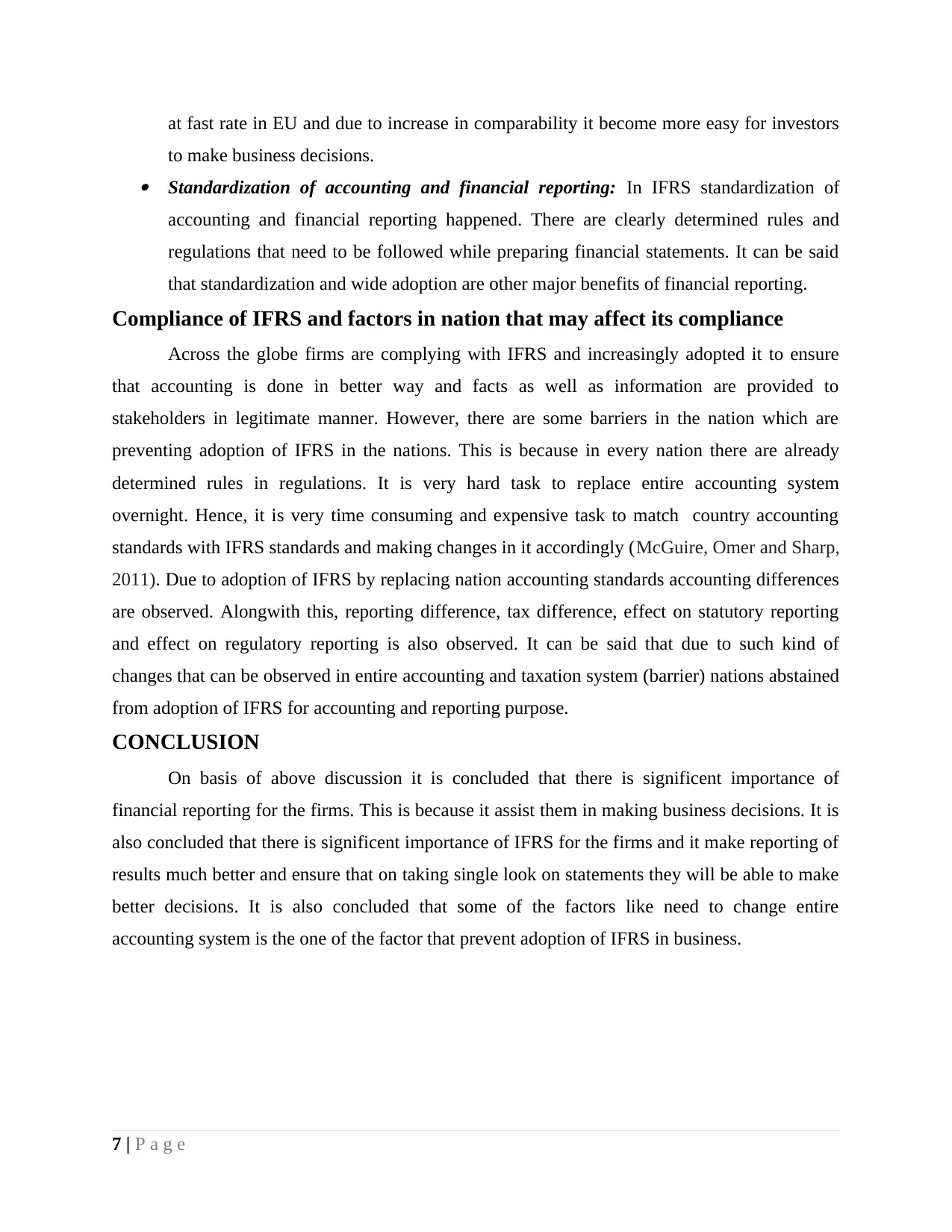
at fast rate in EU and due to increase in comparability it become more easy for investors
to make business decisions. Standardization of accounting and financial reporting: In IFRS standardization of
accounting and financial reporting happened. There are clearly determined rules and
regulations that need to be followed while preparing financial statements. It can be said
that standardization and wide adoption are other major benefits of financial reporting.
Compliance of IFRS and factors in nation that may affect its compliance
Across the globe firms are complying with IFRS and increasingly adopted it to ensure
that accounting is done in better way and facts as well as information are provided to
stakeholders in legitimate manner. However, there are some barriers in the nation which are
preventing adoption of IFRS in the nations. This is because in every nation there are already
determined rules in regulations. It is very hard task to replace entire accounting system
overnight. Hence, it is very time consuming and expensive task to match country accounting
standards with IFRS standards and making changes in it accordingly (McGuire, Omer and Sharp,
2011). Due to adoption of IFRS by replacing nation accounting standards accounting differences
are observed. Alongwith this, reporting difference, tax difference, effect on statutory reporting
and effect on regulatory reporting is also observed. It can be said that due to such kind of
changes that can be observed in entire accounting and taxation system (barrier) nations abstained
from adoption of IFRS for accounting and reporting purpose.
CONCLUSION
On basis of above discussion it is concluded that there is significent importance of
financial reporting for the firms. This is because it assist them in making business decisions. It is
also concluded that there is significent importance of IFRS for the firms and it make reporting of
results much better and ensure that on taking single look on statements they will be able to make
better decisions. It is also concluded that some of the factors like need to change entire
accounting system is the one of the factor that prevent adoption of IFRS in business.
7 | P a g e
to make business decisions. Standardization of accounting and financial reporting: In IFRS standardization of
accounting and financial reporting happened. There are clearly determined rules and
regulations that need to be followed while preparing financial statements. It can be said
that standardization and wide adoption are other major benefits of financial reporting.
Compliance of IFRS and factors in nation that may affect its compliance
Across the globe firms are complying with IFRS and increasingly adopted it to ensure
that accounting is done in better way and facts as well as information are provided to
stakeholders in legitimate manner. However, there are some barriers in the nation which are
preventing adoption of IFRS in the nations. This is because in every nation there are already
determined rules in regulations. It is very hard task to replace entire accounting system
overnight. Hence, it is very time consuming and expensive task to match country accounting
standards with IFRS standards and making changes in it accordingly (McGuire, Omer and Sharp,
2011). Due to adoption of IFRS by replacing nation accounting standards accounting differences
are observed. Alongwith this, reporting difference, tax difference, effect on statutory reporting
and effect on regulatory reporting is also observed. It can be said that due to such kind of
changes that can be observed in entire accounting and taxation system (barrier) nations abstained
from adoption of IFRS for accounting and reporting purpose.
CONCLUSION
On basis of above discussion it is concluded that there is significent importance of
financial reporting for the firms. This is because it assist them in making business decisions. It is
also concluded that there is significent importance of IFRS for the firms and it make reporting of
results much better and ensure that on taking single look on statements they will be able to make
better decisions. It is also concluded that some of the factors like need to change entire
accounting system is the one of the factor that prevent adoption of IFRS in business.
7 | P a g e
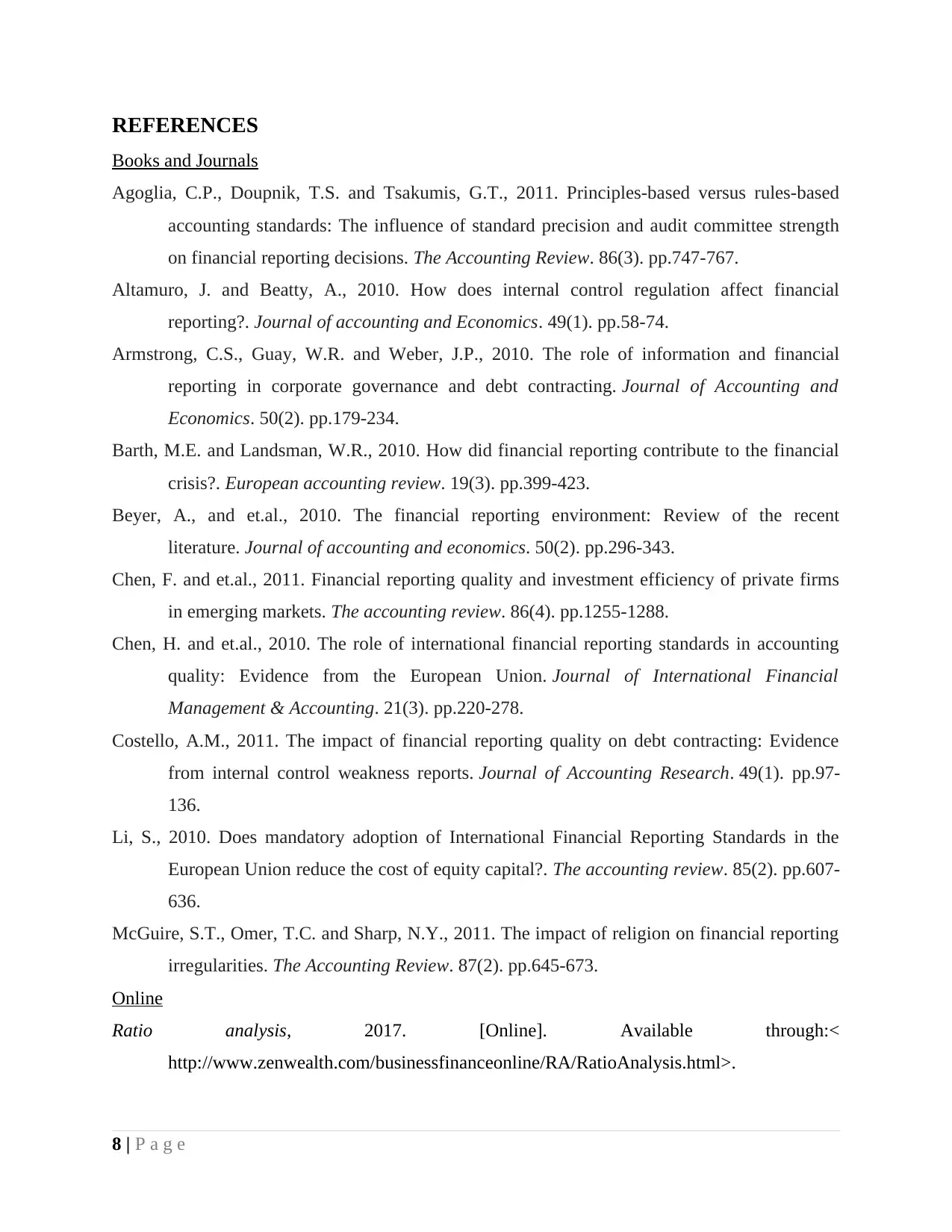
REFERENCES
Books and Journals
Agoglia, C.P., Doupnik, T.S. and Tsakumis, G.T., 2011. Principles-based versus rules-based
accounting standards: The influence of standard precision and audit committee strength
on financial reporting decisions. The Accounting Review. 86(3). pp.747-767.
Altamuro, J. and Beatty, A., 2010. How does internal control regulation affect financial
reporting?. Journal of accounting and Economics. 49(1). pp.58-74.
Armstrong, C.S., Guay, W.R. and Weber, J.P., 2010. The role of information and financial
reporting in corporate governance and debt contracting. Journal of Accounting and
Economics. 50(2). pp.179-234.
Barth, M.E. and Landsman, W.R., 2010. How did financial reporting contribute to the financial
crisis?. European accounting review. 19(3). pp.399-423.
Beyer, A., and et.al., 2010. The financial reporting environment: Review of the recent
literature. Journal of accounting and economics. 50(2). pp.296-343.
Chen, F. and et.al., 2011. Financial reporting quality and investment efficiency of private firms
in emerging markets. The accounting review. 86(4). pp.1255-1288.
Chen, H. and et.al., 2010. The role of international financial reporting standards in accounting
quality: Evidence from the European Union. Journal of International Financial
Management & Accounting. 21(3). pp.220-278.
Costello, A.M., 2011. The impact of financial reporting quality on debt contracting: Evidence
from internal control weakness reports. Journal of Accounting Research. 49(1). pp.97-
136.
Li, S., 2010. Does mandatory adoption of International Financial Reporting Standards in the
European Union reduce the cost of equity capital?. The accounting review. 85(2). pp.607-
636.
McGuire, S.T., Omer, T.C. and Sharp, N.Y., 2011. The impact of religion on financial reporting
irregularities. The Accounting Review. 87(2). pp.645-673.
Online
Ratio analysis, 2017. [Online]. Available through:<
http://www.zenwealth.com/businessfinanceonline/RA/RatioAnalysis.html>.
8 | P a g e
Books and Journals
Agoglia, C.P., Doupnik, T.S. and Tsakumis, G.T., 2011. Principles-based versus rules-based
accounting standards: The influence of standard precision and audit committee strength
on financial reporting decisions. The Accounting Review. 86(3). pp.747-767.
Altamuro, J. and Beatty, A., 2010. How does internal control regulation affect financial
reporting?. Journal of accounting and Economics. 49(1). pp.58-74.
Armstrong, C.S., Guay, W.R. and Weber, J.P., 2010. The role of information and financial
reporting in corporate governance and debt contracting. Journal of Accounting and
Economics. 50(2). pp.179-234.
Barth, M.E. and Landsman, W.R., 2010. How did financial reporting contribute to the financial
crisis?. European accounting review. 19(3). pp.399-423.
Beyer, A., and et.al., 2010. The financial reporting environment: Review of the recent
literature. Journal of accounting and economics. 50(2). pp.296-343.
Chen, F. and et.al., 2011. Financial reporting quality and investment efficiency of private firms
in emerging markets. The accounting review. 86(4). pp.1255-1288.
Chen, H. and et.al., 2010. The role of international financial reporting standards in accounting
quality: Evidence from the European Union. Journal of International Financial
Management & Accounting. 21(3). pp.220-278.
Costello, A.M., 2011. The impact of financial reporting quality on debt contracting: Evidence
from internal control weakness reports. Journal of Accounting Research. 49(1). pp.97-
136.
Li, S., 2010. Does mandatory adoption of International Financial Reporting Standards in the
European Union reduce the cost of equity capital?. The accounting review. 85(2). pp.607-
636.
McGuire, S.T., Omer, T.C. and Sharp, N.Y., 2011. The impact of religion on financial reporting
irregularities. The Accounting Review. 87(2). pp.645-673.
Online
Ratio analysis, 2017. [Online]. Available through:<
http://www.zenwealth.com/businessfinanceonline/RA/RatioAnalysis.html>.
8 | P a g e
1 out of 10
Related Documents
Your All-in-One AI-Powered Toolkit for Academic Success.
+13062052269
info@desklib.com
Available 24*7 on WhatsApp / Email
![[object Object]](/_next/static/media/star-bottom.7253800d.svg)
Unlock your academic potential
© 2024 | Zucol Services PVT LTD | All rights reserved.





